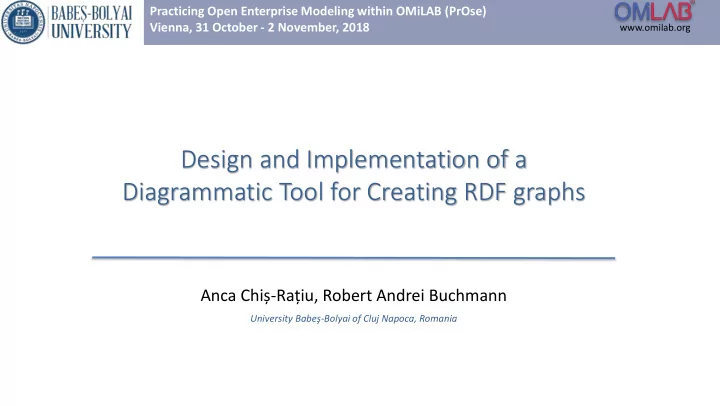

Practicing Open Enterprise Modeling within OMiLAB (PrOse) Vienna, 31 October - 2 November, 2018 www.omilab.org Design and Implementation of a Diagrammatic Tool for Creating RDF graphs Anca Chiș - Rațiu , Robert Andrei Buchmann University Babe ş -Bolyai of Cluj Napoca, Romania
Where am I from? • Babeș -Bolyai University of Cluj-Napoca, Romania • largest and highest ranked University in Romania • biggest city in Transylvania and friendliest city for foreigners • Business Informatics Research Center Research topics: • Knowledge Management Systems • Business Process Management • Distributed Systems PrOse 2018 2
Agenda • Goal & Motivation • Background on RDF • Background on AMME & ADOxx • Proposed Tool & Implementation Details • Related Works • Conclusions & Outlook PrOse 2018 3
Goal statement • Present a modeling tool customized for creating Resource Description Framework (RDF) graphs, by integrating notions of: – Conceptual Modeling – Agile Modeling Method Engineering (AMME) framework (ADOxx for implementation) - Model-driven code generation paradigm => a starting point to develop an OMiLAB project. PrOse 2018 4
Goal Statement • We propose the notion of TSML (Technology-specific Modelling Language) as a flavor of DSML (Domain-specific Modelling Languages) – DSML = domain-specific concepts and properties become first-class modelling citizens (rather than interpretations on generic concepts) – Similarly, TMSL aims to assimilate technology-specific concepts/properties: • For what purpose? Code generation for technology-specific platforms In our case, the target technological space is RDF* *see https://www.w3.org/RDF/ (the Resource Description Framework ) Our means of realizing Technology-specific Modelling Tools: Agile Modelling Method Engineering (AMME) PrOse 2018 5
Motivation Goal: Resolve fundamental enterprise-level issues regarding the production of knowledge graphs by: • Minimizing the effort of RDF data creation • Easily incorporate additional functionality if needed (AMME-driven) • Generate machine-readable knowledge graphs out of diagrammatic structures PrOse 2018 PrOse 2018 6 6
Why RDF? • It is the underlying technology for the Linked Enterprise Data paradigm* • The data model is more flexible than traditional relational databases • Easily manages many-to-many relationships • Supports schemaless graph databases (data can be created before deciding on a schema) • Supports knowledge representation and reasoning use cases *see Wood, D., Linked Enterprise Data, Springer, 2010 PrOse 2018 7
Modelling data as a graph PrOse 2018 PrOse 2018 8
Background on RDF data graphs PrOse 2018 9
Background on Agile Modelling Method Engineering* META-META LAYER subclass el The (fixed) concepts that can be used 1 0..* 0..* 1 source to agilely tailor modelling languages (metamodels) 1 0..* Class Relationship target META LAYER The Metamodel underlying the RDF formal semantics MODELS LAYER The RDF knowledge graphs Modelling language increments (AMME iterations necessary for evolving the tool ) * cf. Karagiannis, D. (2015). "Agile modelling method engineering" In: Proceedings of the 19th Panhellenic Conf. on Informatics . Ed. by N. Karanikolas, D. Akoumianakis, N. Mara, D. Vergados, X. Michalis, ACM, p. 5-10. PrOse 2018 10
How ADOxx was employed • Allows the implementation of a modeling language notation, grammar and vocabulary => Our tool enables the creation of RDF graphs by visual means • Internal scripting language allows the implementation of model-based functionality => Our tool generates N-triples serializations from the visual structures 11 PrOse 2018
Proposed Modelling Language: Metamodel PrOse 2018 12
Proof-of-concept: Model Example PrOse 2018 13
ADOxx Script script sample for generating N-triples PrOse 2018 14
Development method Phase 3. AMME lifecycle (iterations for improvement and extension driven by additive requirements) Phase 1. ADOxx Phase 2. Abstraction exercise implementation exercise (how the results illustrate the (guided by the abstract notion of Modelling requirement to support Method) basic RDF editing) Phase 4. Opening the tool as OMiLAB project (TBD) PrOse 2018 PrOse 2018 PrOse 2018 15 15
Related Work and Proposed Benefits Some other tools that have been developed during recent times for RDF processing: – TopBraid Composer – Callimachus – Protégé – RDF Studio However, such tools provide plug-ins for visualization of already created graphs , rather than the possibility of creating RDF with a modelling look&feel Recent tool closer to our goals: OWLGrEd (http://owlgred.lumii.lv/) However, we aim for an open source tool that can be easily evolved by anyone cf. the OMiLAB philosophy and AMME's iterative nature PrOse 2018 16
Conclusions • This tool contributes to research related to the implementation of RDF modeling tools • RDF graphs should be created as easily as filling data in SQL tables, even in the absence of a schema => potential impact in the Linked Enterprise Data area with respect to usability of knowledge graph creation Outlook: To further evolve the tool towards an ontology design environment PrOse 2018 17
Thank you! Anca Chis-Ratiu Robert Buchmann achisratiu@yahoo.com robert.buchmann@econ.ubbcluj.ro PrOse 2018 18
Recommend
More recommend